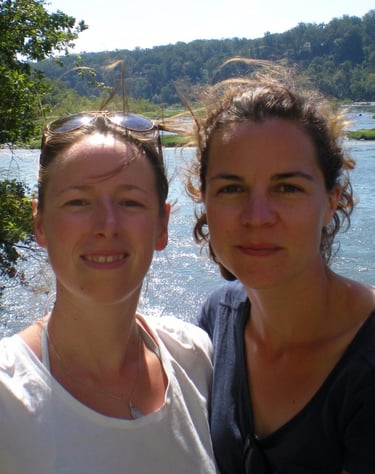About


"When we had the opportunity to buy Le Boulay, we couldn't pass it up. We could only see the potential, not just for the property, but for ourselves as well. We could reduce our impact on the planet by living off the land, we could support our community, we could give something back. We knew we'd found our little piece of paradise and that this is where our life would be."
Magali and Catherine
A long story short
Even though it seems older, the house was only built during the 1960s by Magali’s grandparents, just next to the home of her great-grandparents. It was used as a goose farm for many years by Mamie (Magali's grandmother) and her children.
It's hard to imagine now, but during the construction of the house, there weren't any plants or trees around at all. But as Mamie was a bit like a bird that sowed seeds everywhere, Le Boulay is now surrounded by lots of trees and plants, most of which you wouldn't think would grow in the North West of France.
Magali spent a large part of her childhood holidays and weekends at Le Boulay, and always loved being there. So when we were given the opportunity to buy Le Boulay, we couldn't pass it up.
Nature has taken over the farm buildings and there's a lot of work to do, but we can only see the potential to bring new life to Le Boulay in an innovative way. We just have to prioritise and start at our frontdoor.
We still make fun of Mamie sometimes as she never wanted to trim, cut or chop anything, but nowadays she would definitely be called a permaculture pioneer! Thanks to her, we're lucky to live in this haven of peace, our little wild paradise as we like to call it.
The Farm
With a total of two hectares, the farm is made up of two orchards, a meadow, a pond and two main gardens where we grow our vegetables, the Squirrel Garden and the Pond Garden.
The Squirrel Garden was originally a potato field that family members used every year. The soil is fertile but has been compacted down by the tractor over the years. We're now using regenerative farming methods to keep the life in the soil intact. We made the beds with a Grelinette (a broadfork) to aerate the soil without turning it over, adding cardboard, compost, grass clippings, wood chips, hay, rabbit fumure and more of what we find here. It's also in this garden that we've installed our natural filtration system with reedbeds.
After spending a lot of time observing what grows, where the wind is, and where the sunny spots were, we started by planting perennials like borrage, hemeroccallis (day lilies), asparagus, strawberries, raspberries etc… in the places that we thought would best suit them. We created a map of our beds so we knew what we were planting where and what companion planting we could do. We're experimenting with what works and what doesn't, learning a lot from books and YouTube, but we're also observing as much as we can so we can see how they work with the already existing ecosystem and adapting as we go.
We're lucky to already have many fruit and nut trees so we can harvest and enjoy them now, but we'll be planting more in the winter to replace fallen or old ones.
We have chickens, and move their chicken house around the garden as we need, Indian Runner ducks, who help us in our fight against too many slugs in the garden, rabbits, a beehive, and two alpacas (Denver and Alpacino).
The Tiny House
In August 2020, we finally got our Tiny House from the amazingly talented team at Baluchon, near Nantes.
Built in wood, handcrafted, sustainable, and ecologically friendly, a Tiny House is a small chalet installed on a 6 metre long trailer, it’s 2.55 m wide and 4.15 m high. Tiny Houses are often compared to roulottes (the French name for a horse-drawn gypsy caravan), however they can be towed on the road behind a (strong) car, like a caravan. A Tiny House is just like a real house, well-insulated and with all the cosiness of a big one, maybe even more!
So here it is, La Tiny Kiwi, named in honour of New Zealand, Catherine’s country of origin. And yes, a kiwi isn't only the name of a fruit, it’s also a bird with a long beak native to New Zealand and how people from New Zealand are proudly called!
With its natural colours blending into the landscape, the huge patio door to admire the nature and animals as if you were outside, but in the warmth (or chilling), La Tiny Kiwi offers you a total change of scene, a unique stay that will awake the curiosity in everyone
Le Bourg D'Iré
The beautiful and historic village of Le Bourg d’Iré sits upon the river Verzée and is part of Segré en Anjou Bleu, in the Maine et Loire. It recently gained its first flower in the coveted national label for flowered cities and villages.
You can follow the heritage walking and cycling paths and enjoy the beautiful countryside at your own pace. Set North of the Loire Valley, included on UNESCO’s World Heritage list and zone NATURA 2000, a multitude of castles, churches, abbeys, parks, slate mines, rivers, vineyards and other jewels surround us, there's something for everyone.
Many restaurants will know how to treat your tastebuds, including l’Auberge de la Diligence, in the neighbouring village of Loiré, just a few minutes drive from Le Boulay.
Our location
Address
553 chemin des Boulays
Le Bourg D'Iré
Segré en Anjou Bleu
49520
France
